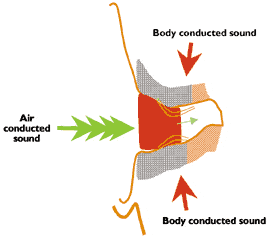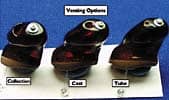Hearing instrument users need their amplification to improve speech intelligibility in all acoustic environments, provide a pleasant sound quality, and preserve comfortable loudness. Moreover, the instrument should provide a good cosmetic appearance, while allowing easy operation of its features. In order to meet these needs for each individual, the dispensing professional requires more tools for interactive fitting and fine-tuning of complex hearing systems for the optimal use of the hearing instrument features.
This article reviews the results of a clinical study of the Claro 211 dAZ BTE hearing instrument, conducted at the university at Hörzentrum Oldenburg, Germany. The goal of the study was to assess the efficiency of Adaptive digital AudioZoom (dAZ) in noisy environments and to evaluate the use of the WatchPilot remote control in everyday use by patients.
Adaptive digital AudioZoom (dAZ) is an adaptive digital multi-microphone technology designed to automatically adapt the directivity pattern to the environment and attenuates noise in an arc from +90° to –90° behind and to the sides of the user. The “WatchPilot” is the first remote control to be housed within a fully-functional wristwatch. End-user benefit from the instrument’s Loudness Perception Profile (LPP) and AutoSelect was demonstrated in a clinical study conducted for the Claro 22 ITE-hearing instrument.1
Test Subjects
Twenty hearing-impaired subjects (ages 26-76 years old, mean: 58 years) with moderate symmetrical sensorineural hearing losses participated in the field test. Of the 20 participants, 10 were female and 10 male. Half of the subjects were experienced BTE hearing instrument wearers. Figure 1 shows the mean thresholds and uncomfortable loudness levels for the 20 subjects, as well as the standard deviations.

|
|
|
Hearing Aid Features
The “QuietAdapt” (QA) program of the test instrument is designed to optimize speech intelligibility and sound quality in quiet situations. The second program, “NoiseAdapt” (NA), aims to optimize signal-to-noise ratio (SNR) and comfort for communication in background noise. (Author’s Note: The third program, which caters to other individual wishes, such as a program for the telephone or listening to music, was not part of the investigations).
The AutoSelect mode of the test instrument enables automatic switching between the hearing programs QA and NA, depending on the acoustic environment. While previous studies have shown the AutoSelect mode to be effective and rated highly with end-users,1,2 user-operable controls (eg, remote controls) are still an important option to provide flexibility for the user. The WatchPilot remote control has a practical operating distance of up to about 1.5 ft. (50 cm). Thus, the natural position for reading a watch is the position to use the remote control function. Function keys on the remote control select the mode/program and change the volume.
The use of directional microphones and multi-microphone technology for the improvement of SNR has proven to be the most successful strategy for speech intelligibility in background noise.3-9 In contrast to conventional dual-microphone technology, which has a fixed direction of maximal noise suppression, an adaptive, digital multi-microphone technology (ie, dAZ) is applied in the NA program of the test instruments. The processor adjusts the polar response to ensure a minimum total output power from the two microphones.
In effect, this function provides minimum sensitivity in the direction of the highest signal level in the rear plane. It is performed with the assumption that useful signals come from the front, and it results in an optimal attenuation of noise from the side and/or behind the user, depending on the situation. The instrument is designed to track the noise source as it moves so the directional performance is continually optimized.
Testing Methods
Measurements and questionnaires reported here were performed during five office visits. At the first appointment ear impressions were taken for the earmolds after establishing a pure tone audiogram.
All subjects performed an unaided Oldenburg Sentence Test10 in two different spatial conditions. The Oldenburg sentence test determines the speech-reception threshold (SRT) in noise that corresponded to the signal-to-noise ratio (SNR) at which speech intelligibility is at 50%. Within a single measurement run, 30 sentences were presented from a loudspeaker placed at 0° azimuth to the listener at a distance of 1 meter. In one condition, a speech-simulating background noise (fixed at 65 dB SPL) was presented from -90° and 90°, again at a distance of 1 meter. In another condition, the noise was presented from -165° and 165° at a distance of 1 meter. The listener had to repeat each word of the sentence that he/she understood. The volume of the speech was adaptively adjusted for each subject to determine the SRT.
At the second visit, each participant was provided with new earmolds and was fitted binaurally with new Claro 211 dAZ BTE hearing instruments. These test devices were pre-programmed according to DSL[i/o] using the individual hearing threshold and uncomfortable loudness level. As allowed by the software, adjustment was made individually according to “Experience level.” The initial setting of the hearing instruments was evaluated using an “environment tour” in the surroundings of the Hörzentrum Oldenburg, which covered different acoustic situations.
The preprogrammed setting was tested for one week in everyday life at home. Each participant also received a WatchPilot as a remote control. The fine-tuning of the test instruments was made on the basis of the subjects’ comments at the third appointment. At the fourth appointment, further fine-tuning was made, if necessary.
All subjects tested the hearing instruments and the remote control for at least four weeks in everyday life. The AutoSelect mode and the dAZ were activated during this long-term testing.
Additionally, the subjects wore the test instruments at home and answered a questionnaire which incorporates (among other things) part of the Oldenburg Inventory.11 The questionnaire, developed by Phonak, included questions about loudness, speech intelligibility, sound quality, and the handling of the instruments including the functionality of the remote control.
At the fifth, final visit, each subject was given a sentence test using the QA program with noise presented from behind and from the sides in order to determine the benefit of the hearing instruments with omnidirectional microphones. In order to determine the benefit of the dAZ, a sentence test was presented using the NA program; once with dAZ and once with a fixed cardioid directional performance, and for both spatial conditions. The order of measurements was randomized with regard to the microphone settings and spatial conditions.
Results and Discussion
Sentence Test: The mean results of the sentence tests appear in Figure 2. When noise was presented from the sides, subjects achieved approximately the same SRT when unaided and using the QA setting of the test instruments with omni-directional microphones. Differences were not statistically significant (paired t-Test, p<0.05).

|
|
|
Using the NA setting with fixed directional microphones, the SRT was 3.5 dB less than when using the QA setting with omni-directional microphones. Thus, speech intelligibility was improved for noise coming from the sides even though the fixed cardioid directivity pattern is optimized for noise from behind. The dAZ implemented in the NA program yielded an additional 2.5 dB SNR improvement compared to the fixed directional microphones and therefore about 6 dB SNR benefit compared to the QA setting. The differences between dAZ and fixed directional microphones, as well as between the QA setting and each of the NA settings, were statistically significant.
For the condition where noise was presented from behind, when using the QA setting, subjects required a 1 dB higher SNR on average than they required unaided. However, this difference was not statistically significant. Compared to the QA setting, subjects showed a benefit of at least 8 dB SNR from the directional microphones. As expected, the difference between the fixed or dAZ microphone setting was not statistically significant for this condition, since the fixed cardioid pattern is optimized for noise coming from behind the listener.
The results of these speech intelligibility measurements in noise are in accordance with the findings reported by Kühnel & Checkley.8
Questionnaire Results
According to the questionnaire answered by the participants during the long-term testing, the subjects’ use of the QA setting resulted in a “very good” and “easy” understanding in quiet environments. For intelligibility, the scale included the categories “nothing,” “very few,” “few,” “medium,” “much,” “very much” and “everything,” whereas for the listening effort possible answers were “very strenuous,” “strenuous,” “medium,” “easy” and “very easy.” On a scale of categories from “very dissatisfied,” “dissatisfied,” “neither nor,” “satisfied” to “very satisfied,” the subjects reported they were “satisfied” with the test instruments in quiet environments.
Using the NA setting with the dAZ in noisy environments, subjects reported improved intelligibility and less listening effort in noisy environments compared to the QA setting with omnidirectional microphones. They were neither satisfied nor dissatisfied with the test instruments in noisy environments. Thus, subjective data and results from speech intelligibility measurements in noise were consistent.
Subjects rated the general sound quality of the test instruments as “comfortable” on a scale of categories from “very uncomfortable,” “uncomfortable,” “medium,” “comfortable” to “very comfortable.” The shape and design of the test instruments were rated as “good” (possible answers: “very bad,” “bad,” “acceptable,” “good,” or “very good”).
Asked for their overall impression of the test instruments, subjects were “satisfied” with the devices. Moreover, subjects who were experienced users and who were satisfied with their current hearing instruments at the outset of the study judged the test instruments slightly better than their own hearing aids.
While only 10% of the subjects had used a remote control before the present study, all subjects reported that they used the remote control during the long-term testing. The majority (>80%) of the subjects used the remote control more often than the manual (TacTronic) switch on the BTE hearing instrument for modifications to the hearing instruments.
Figure 3 shows that most participants used the remote functions 3-10 times a day. Although the remote control switched the program as desired, only about half the subjects said that both hearing instruments switched programs simultaneously. Subjects rated the handling of the remote control as easy and reported that their arm was in a comfortable position when using it.

|
|
|
The questionnaire revealed that the design of the WatchPilot remote control was rated as “acceptable” or “good” (possible answers: “very bad,” “bad,” “acceptable,” “good,” “very good”). However, female participants expressed a preference that it be smaller, even though they had received the smaller of the two available designs. (Male participants had received the larger design.)
Although, subjects rated the AutoSelect mode as useful after the long-term testing of the hearing instruments, the option of manual program choice was reported as quite useful, as the AutoSelect mode is not able to categorize all acoustic environments 100% correctly in terms of all individual preferences for a given acoustic environment.
In general, subjects spoke positively about the integration of a remote control for hearing instruments in a watch, and the results of the present study confirm the findings from a preliminary field trial12 conducted to assess the functionality of the remote control housed in a wristwatch.
Summary
Results of this clinical study indicate that the hearing-impaired listeners were able to achieve an improvement of up to 8 dB SNR with the directional microphones compared to omni-directional microphones when noise was presented from behind. The adaptive directional microphone technique led to an additional improvement of speech intelligibility when noise was presented to the sides compared to a fixed cardioid directional pattern. Subjects also reacted positively to the idea of the remote control housed in a wristwatch, and the fact that this remote control was “always at hand” to facilitate discreet modifications to the hearing instrument was well-liked.
| This article was submitted by Birgitta Gabriel, PhD, who is a professor at the University of Oldenburg in Oldenburg, Germany. Correspondence can be addressed to HR or Birgitta Gabriel, Hörzentrum Oldenburg, c/o Universität Oldenburg, Carl-von-Ossietzky Str. 9-11, 26111 Oldenburg; email: [email protected]. |
References
1. Gabriel B. The benefit of modern hearing aid features for hearing aid users based on the example of a special hearing aid type. Hear Jour. 2002. In press.
2. Büchler M. How good are automatic program selection features? Hearing Review. 2001; 8(9), 50-54.
3. Valente M, Fabry DA, Potts LG. Recognition of speech in noise with hearings aids using dual microphones. J Am Acad Audiol. 1995; 6(6):440-449.
4. Valente M. The bright promise of microphone technology. Hear Jour. 1998;51 (7), 10-19.
5. Kochkin S. Customer Satisfaction and subjective benefit with high performance hearing aids. Hearing Review. 1996;3 (12):16-26.
6. Ricketts T. Impact of noise source configuration on directional hearing aid benefit and performance. Ear Hear. 2000; 21(3): 194-205.
7. May A, Larsen, C, Warland A. Multi-microphone instruments, DSP and hearing-in-noise. Hearing Review. 1998;5 (7): 42-45.
8. Kühnel V, Checkley P. Advantages of an adaptive multi-microphone system. Hearing Review. 2000; 7 (5): 58-60, 74.
9. Pumford JM, Scollie SD, Jenstad LM. Speech recognition with in-the-ear and behind-the-ear dual-microphone hearing instruments. J Am Acad Audiol. 2000;11 (1): 23-35.
10. Wagener K, Brand T, Kollmeier B. Entwicklung und evaluation eines satztests in deutscher Sprache III: Evaluation des Oldenburger satztests. Z Audiol. 1999; 38(3):86-95.
11. Holube I, Kollmeier B. Modifikation eines Fragebogens zur erfassung des subjektiven hörvermögens und dessen beziehung zur sprachverständlichkeit in ruhe und unter störgeräuschen. Audiol. Akust. 1994;33:22-35.
12. Kalis S. A Combination hearing aid remote control and watch. Hearing Review. 2000; 7 (10) 60.






